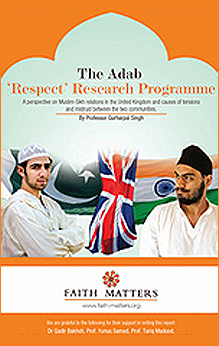
Author: Gurharpal Singh
Publisher: Faith Matters
Release Date: May 2010
Pages: 56
Source: https://www.faith-matters.org/2010/05/06/adab-research-report/
The report “draws mainly on published secondary sources” and forms part of the ‘Adab (Respect) Research Programme’ initiated by a UK networking and consulting ‘community interest company’, Faith Matters. This body, founded by Mr Fiyaz Mughal, is not to be confused with the better known Faith Matters project of the Churches Regional Commission.
The focus on Muslim-Sikh relations is a curious one given the alternative options of studies of Muslim-Jewish relations or for that matter Evangelical Christian-Jewish relations. The highlighting of Muslim-Sikh relations is not particularly high on the agendas of either Muslim or Sikh communities and the issues which have arisen recently – such as the Dubai trial of migrant workers – are of a tangential nature for communities in Britain.
Nevertheless Professor Singh’s scholarly literature review is to be commended for nailing the myth of Muslims grooming Sikh girls for conversion. He notes, “no case of forced conversion has been recorded by the police so far….while there were a few publicized cases of this in the late 1980s, no one has been able to prove that these were anything other than isolated incidents or that it is still going on”.
For completeness’s sake, Professor Singh’s review ought to have included some of the interactions between representative Sikh and Muslim bodies. For example the Muslim Council of Britain (MCB) and affiliates such as the Federation of Students Islamic Societies (FOSIS) have taken steps to maintain cordial relations with the Sikh community and address common concerns. Muslim and Sikh organizations were both important members of the interfaith campaign for the religion question in the 2001 Census – in which Indarjit Singh, representing the Network of Sikh Organisations, played an important role. In July 2002, Indarjit Singh also participated and spoke at an interfaith goodwill conference organized by the MCB at a time of political tensions between India and Pakistan. More recently, FOSIS has met the Sikh Community Action Network on the issue of hate blogs, and the MCB has endorsed the message of sympathy following the arson attack on an East London gurdwara. There are thus well-established networks and attempts to over-dramatise community tensions are unwarranted and poor use of resources.
Professor Singh’s report builds on a residential workshop conducted by Faith Matters also funded by CLG. This was held at the Corrymeela conflict resolution centre in Northern Ireland in July 2008. Professor Singh has dropped one of the recommendations from Corrymeela: “a national Muslim/Sikh Forum of Commissioners should be set up with 5 Muslim and 5 Sikh commissioners who should work on a regional basis. They will act as bridge between Government, local authorities, regional development authorities, other statutory sources (sic) and grass roots Sikh and Muslim communities. They should meet on a quarterly basis….”.
In this report Professor Singh makes the case for the recognition of a ‘Punjabi’ identity in Britain which co-exists with Indian-Pakistani or Hindu-Muslim identities. He sees much in the ‘bhangra’ phenomenon – “since the early 1980s and the 1990s bhangra has become the emblem of British Punjabis, coinciding with the emergence of an identifiable youth culture . . . the growth of the bhangra industry, and its global impact, has been hailed as the precursor of social hybridities, cross-over and multiple-identities which explodes the myth of dominant discourse of ethnic and religious identities among Britain’s minority populations”.
There is a danger of overselling bhangra as a community cohesion balm. It remains a catchy folk song-and-dance tradition, but one overshadowed by the more potent hip hop genre that incorporates subversion, protest and expression of youthful angst. If YouTube and Islamic events are markers, then Muslim youth culture has found a cultural vehicle that out paces bhangra.
Professor Singh’s report sends mixed signals on Islamophobia. On the one hand it rightly quotes Ceri Peach’s research highlighting the double penalty faced by Muslims – racial as well as religious discrimination – yet it states “the issue remains that the discourse of Islamophobia among religious minorities has the potential to breed political extremism”. In other words, Muslims should grin and bear it and adopt a quietist strategy because protest against injustice would trigger a back lash.
Why is it that the robust campaigns one sees against anti-semitism could not be adopted in confronting Islamophobia? That there is a reluctance in treating anti-semitism and Islamophobia at par is no doubt – the All-Party Parliamentary Group on Anti-Semitism rejected the proposal in 2009 that it should extend its mandate and recast itself as the ‘All-Party Parliamentary Group on Anti-Semitism and slamophobia’. There is need for solidarity in the battle against Islamophobia. Why there is a singular silence from such quarters could perhaps be another study commissioned by the Adab ‘Respect’ research programme.
M. A. Sherif, 2010
